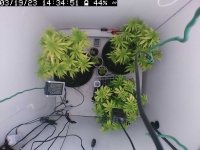Big swings in pH always causes problems.
Try to go up or down only 0.2 points at a time.
I’m not a liquid nuts expert, but excess Ca can antagonize Mn by precipitate it out, especially in the presence of carbonates and bicarbonates in the water.
I would try backing off on the CalMag, especially if you have decent alkalinity in your tap water.
Unfortunately it's been going on longer than that...It's not a deficiency, it's toxicity.
I'm interested by the comment it could be Na (salt) and wonder if road salt might be involved, as it's that time of year.
I think it might be light poisoning rather than nutrient issuses. At 70 F / 33% RH, your room is likely too cold and too dry, so the plants can't convert all that strong LED light.
It seems to be a common problem in cold and dry winter grows under strong led lights. When it happens,, everything else gets out of whack, and it can't even drink much water either.
Remedies:
- Get the temps up by adding a radiator or other heat source (or switch to the old MH or HPS light).
- Get a humidifyer to increase humidity.
- Raise or dim the lights until the plants start picking up again.
- Go very easy on food and water until they start bouncing back.



